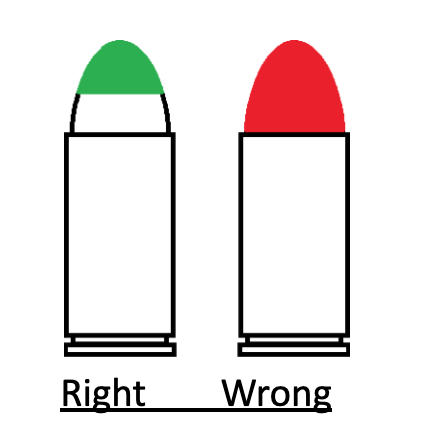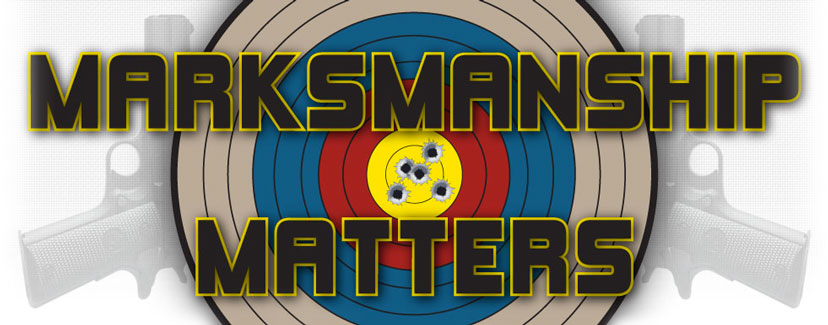Intermediate Pistol Course
The successful completion of the 4-day defensive pistol class is the prerequisite for this course. This two-day course is all conducted on the range.
Upon completion of the Marksmanship Matters Defensive Pistol Course (four day) our clients have acquired a strong foundation in firearms safety, correct pistol manipulation skills, basic tactics and a high degree of accuracy.
Upon graduation they are all given a practice regiment which would take them to the next level while increasing their speed and making their skills habitual. Many of our clients have declined to attend our advanced classes because they have not done the follow up practice and feel unprepared.
The Intermediate class starts exactly where the Defensive Pistol Course concludes. In the Intermediate Class shooters will conduct a regiment of diagnostic drills, skip loading and other exercises while increasing speed and making fundamentals habitual. Upon completion of this course, the shooter will be better prepared for a defensive encounter and competent to attend any of our advanced pistol courses.
See schedule for pricing.
The hours are 0845 to 1700
Intermediate Pistol Equipment List
Handgun– Bring a safe, reliable, accurate and appropriate handgun. The Pistol that you used in P1-P4 will likely be your best choice. Call us if you need help with handgun selection. If you have a spare handgun (and all the accessories and ammunition,) bring them. If your pistol breaks you will be glad that you did. We suggest a striker fired pistol with a consistent trigger press in 9mm if you have the option. We have decades of experience using and training police officers with double action autos, cocked and locked 1911s and revolvers. We do not recommend these systems for the new defensive shooter.
They are more complex in their manipulation or have two different methods of trigger action or their long double action triggers can be difficult to manage. If you bring one of these guns, we know how to train you with it. You will however work harder than you would if you brought one of the pistols that we suggest. See our article on handgun and holster selection.
Magazines– minimum of three functional, reliable high capacity magazines are required for semi auto pistols. If you have a single stack magazine pistol you will need 5 or 6 magazines rather than 3. You should probably own at least 6 magazines for every semi auto pistol that you own. A pistol without magazines is almost useless. Magazines get lost in combat and they break. A minimum of 3 high capacity magazines will be required for the class. More than 3 can be helpful. Six are recommended for general ownership.
Holster– Belt holster carried on the primary side, pistol butt to the rear, leather or kydex, made specifically for the pistol being used, no generic and no nylon holsters. We prefer Kydex holsters for range work and we strongly suggest a vertical draw and not a canted holster. If the package states that the holster will fit a long list of pistols, it will probably not work well. No shoulder or cross draw holsters for range safety. Blade Tech holsters generally work well. Our good friend and fellow instructor Thomas Erickson is local and makes excellent concealed carry holsters. If you want a specific recommendation for a range training holster, we will suggest the following: “Blade Tech, outside the waistband, dropped and offset holster”. Best ordered on line from The Gunsight Pro Shop in Paulden AZ.
Due to the number of people who have accidently shot themselves while drawing from the popular holster which has a plastic tab to unlock the pistol, we cannot allow its use in our classes. If you have a question about this, please call us.
Eye Protection- clear and shaded shooting glasses.
Glove for Your Support Hand- With exposed fingers, to protect the support hand during manipulation and skip loading drills. The glove should be thin in the palm.
This is another must have item. Mandatory for the Intermediate Pistol Class.
Small Pocket Note Book- For taking notes on the range.
Belt- A wide thick belt that will fit and fill your belt loops and accommodate your holster will be required.
Trousers with wide belt loops- such as cargo trousers (preferred) or jeans.
Dummy Rounds- “A-Zoom” brand or “Pink Rhino” brand in the appropriate caliber. A minimum of 20. Essential for manipulation drills and skip loading drills. Due to breakage and malfunctions caused by using Tipton dummy rounds those will not be accepted for use in our class. We have also witnessed accidental discharges which occurred because other dummy rounds being used could not be easily distinguished from live rounds when observed in the feed way during a chamber check.

We suggest that you paint the tip of the nose of the bullets (only) in the dummy rounds so that they will be easier to find on the range and yours can be identified from those of other shooters. learn. Note also if you paint the entire nose of the bullets in the dummy rounds they will become lodged in the firing chamber and leave dry paint residue in the pistol causing malfunctions.
Magazine Pouch- At least one, appropriate for the pistol magazines being utilized.
It should be cut low exposing about half of the magazine. It may be leather or kydex but not nylon.
Dress in Layers- so that you can adapt to changing temperatures.
Boots- or sturdy shoes, high tops providing ankle protection preferred. We are off the concrete. There are rocks and occasionally snakes.
Chair– Folding or Camping chair.
Baseball Cap- A cap or hat, not a visor and make sure it is compatible with your head set and your shooting glasses.
Mosquito Repellent- Optional.
Sun Block- Strongly suggested.
Sun Shade- Umbrella or Awning optional– Beware of strong wind gusts.
Bring a Lunch- You will not have time to leave the range for lunch. This is a time to relax and not rush to get back on time. The dirt road is slow.
Water- We suggest a gallon of drinking water plus sports drinks for electrolytes each range day.
Optional Item-Fire Extinguisher- If you have a fire extinguisher or two please bring them. The possibility of starting a fire with the type of ammunition and targets that we use is almost zero, but due to the recent wild fires we wish to err on the side of caution. If we have 10 or 12 fire extinguishers, shovels and water we should be able to stop a problem before it gets out of hand. Fire can start from a hot exhaust pipe.
Ammunition- Approximately 300 rounds (classes will vary) of reliable, accurate, factory ammunition, no Russian or reloaded ammunition, no tracer ammunition or steel core bullets. We have had serious problems with some “factory loads.” We do not recommend “no name or brand X ammunition”. We had a factory 9mm cartridge rupture blowing the magazine out of the pistol, damaging the magazine beyond repair and stinging the shooters hand. We have seen cheap factory .40 ammunition break up in the barrel and hit the target as a bunch of fragments. As a result, we strongly suggest that you consider bringing only Winchester, Remington, Federal or CCI Lawman Series practice ammunition.
For those who would like a specific ammunition recommendation, our favorite
9 mm practice ammunition in the order of our preference is 147 grain CCI FMJ followed by Winchester or Federal.
We have also had nothing but problems with clients bringing reloaded ammunition. Yours may be great but the problems have been so serious that we have had to stop a class and send everyone to the store to buy factory ammunition so that we could continue the class. As a result, we were forced to adopt this policy. No reloads.
Ammunition– 50 rounds of your everyday carry ammunition. These will usually be quality Jacketed hollow points such as Federal HST or Winchester SXT. This will provide you an opportunity to check zero and function with this ammunition.
Hearing protection- Rubber (not foam) ear plugs on a string and a muff type head set.
Note: Foam ear plugs must be squeezed and compacted with your fingers to get them into your ear canal. Your fingers will be contaminated with airborne lead and Mercury. The time required to compact your ear plugs perhaps 20 times a day adds up. Often shooters will have difficulty compressing their foam ear plugs and cannot get them to properly enter the ear canal while the class stands ready and waits. The soft rubber tapered ear plugs (with multiple flanges) are easy and quick to insert. They do not require you to touch them with your contaminated fingers. If the use of foam ear plugs had not been a constant hindrance in the past, we would not insist on a specific type of plug. You may buy these at Wal Mart or most any sporting goods or gun store.
Note: If you cannot hear the range commands while wearing both plugs and muffs you may wear only the muffs. Wearing only the plugs is insufficient to protect your hearing and is not allowed.
Any questions regarding equipment please call us at 801-669-1886.
Larry and Stacey Mudgett
“Marksmanship Matters”

